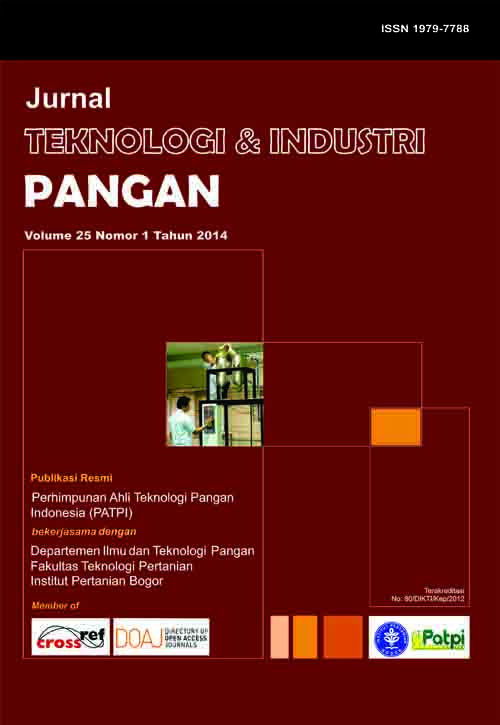OPTIMASI PRODUKSI ENZIMATIS DIASILGLISEROL MELALUI GLISEROLISIS KONTINU [Optimization of Enzymatic Diacylglycerol Production through Continuous Glycerolysis]
Abstract
OPTIMASI PRODUKSI ENZIMATIS DIASILGLISEROL MELALUI GLISEROLISIS KONTINU
[Optimization of Enzymatic Diacylglycerol Production through Continuous Glycerolysis]
Tri-Panji1)*, Septiany C. Palilingan2) dan I Made Artika2)
1) Balai Penelitian Bioteknologi Perkebunan Indonesia, Jl. Taman Kencana No. 1 Bogor
2) Departemen Biokimia, Fakultas Matematika dan Ilmu Pengetahuan Alam, Institut Pertanian Bogor, Bogor
Diterima 24 Juni 2013 / Disetujui 10 Februari 2014
ABSTRACT
Diacylglycerol (DAG) produced from crude palm oil (CPO) is one of the healthy oils that can be consumed for daily human diet. DAG production in Indonesia is constrained by the high cost of the mostly imported lipase. To overcome this problem, research of DAG production has been carried out using crude extracts of lipase produced by local species of fungi Rhizopus oryzae. This study aims to develop a continuous process of enzymatic glycerolysis of CPO for DAG production; to establish optimum conditions of DAG production which includes flow rate of CPO and glycerolysis time; and to test the performance of lipase from the local mold R. oryzae in catalyzing continuous process of glycerolysis for the production of DAG. Lipase isolation was carried out by acetone precipitation and lipase was used as a catalyst in the continuous glycerolysis process. The glycerolysis was conducted by reacting CPO with glycerol continuously at various time periods. The optimum condition of automatic continuous glycerolysis process was achieved at a CPO flow rate of 3 mL/min with a glycerolysis time at the 18 cycles (9 hours). The conversion of DAG was 29%. The performance of lipase was proven to remain stable up to 3 times changes of CPO substrate for 9 hours of glycerolysis process with the best condition at the 3 cycles and can improved conversion of DAG until 37%.

